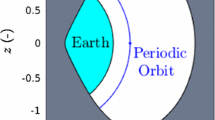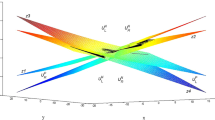Abstract
The configuration space around the triangular libration points in the Earth-Moon system is partitioned according to the stability of the motion. The regions aroundL 4 andL 5 are established where particles placed with zero initial velocity will librate. The complexity of the partitioning is revealed.
Similar content being viewed by others
References
Plummer, H.: 1918,An Introductory Treatise on Dynamical Astronomy, Cambridge University Press, London.
Poincaré, H.: 1896,Compt. Rend. 123, 1224.
Prigogine, I.: 1977,Celes. Mech. 16, 489.
Rabe, E.: 1961,Astron. J. 66, 500.
Szebehely, V.: 1967,Theory of Orbits, Academic Press, N.Y.
Szebehely, V. and Cooper, W.: 1979 NASA-JSC Report.
Whittaker, E.: 1904,Analytical Dynamics, Cambridge University Press, N.Y.
Author information
Authors and Affiliations
Rights and permissions
About this article
Cite this article
McKenzie, R., Szebehely, V. Non-linear stability around the triangular libration points. Celestial Mechanics 23, 223–229 (1981). https://doi.org/10.1007/BF01230727
Received:
Accepted:
Issue Date:
DOI: https://doi.org/10.1007/BF01230727




